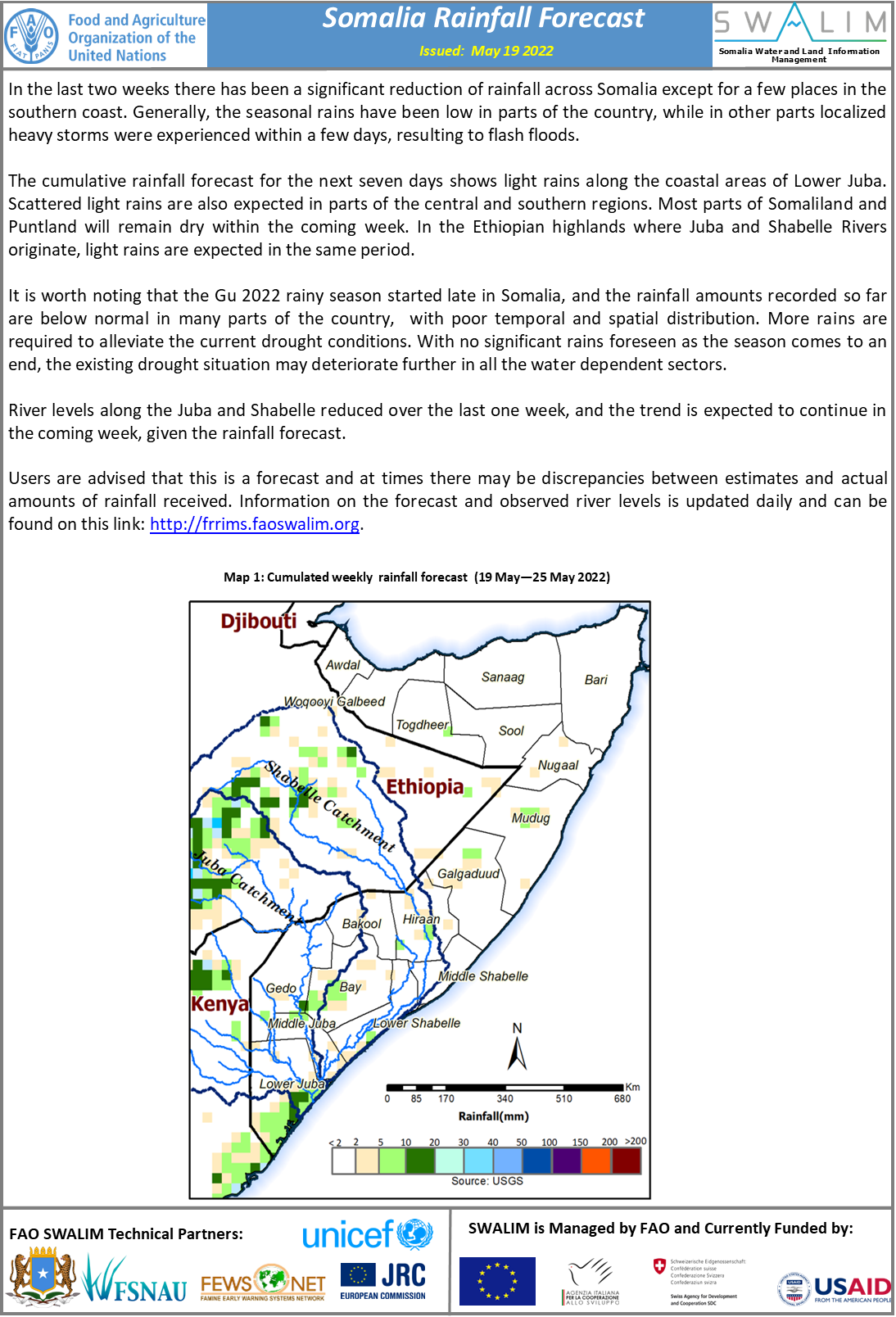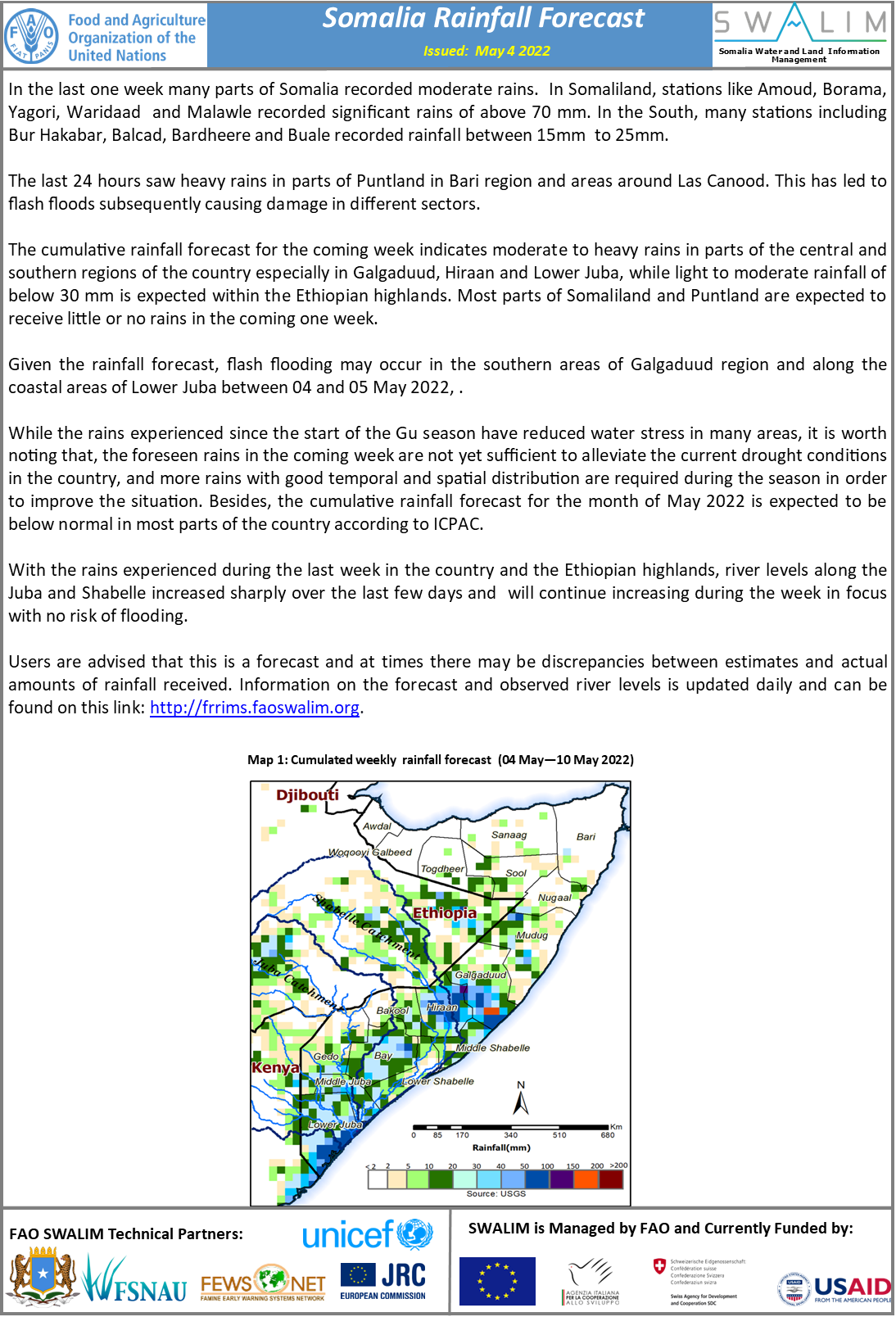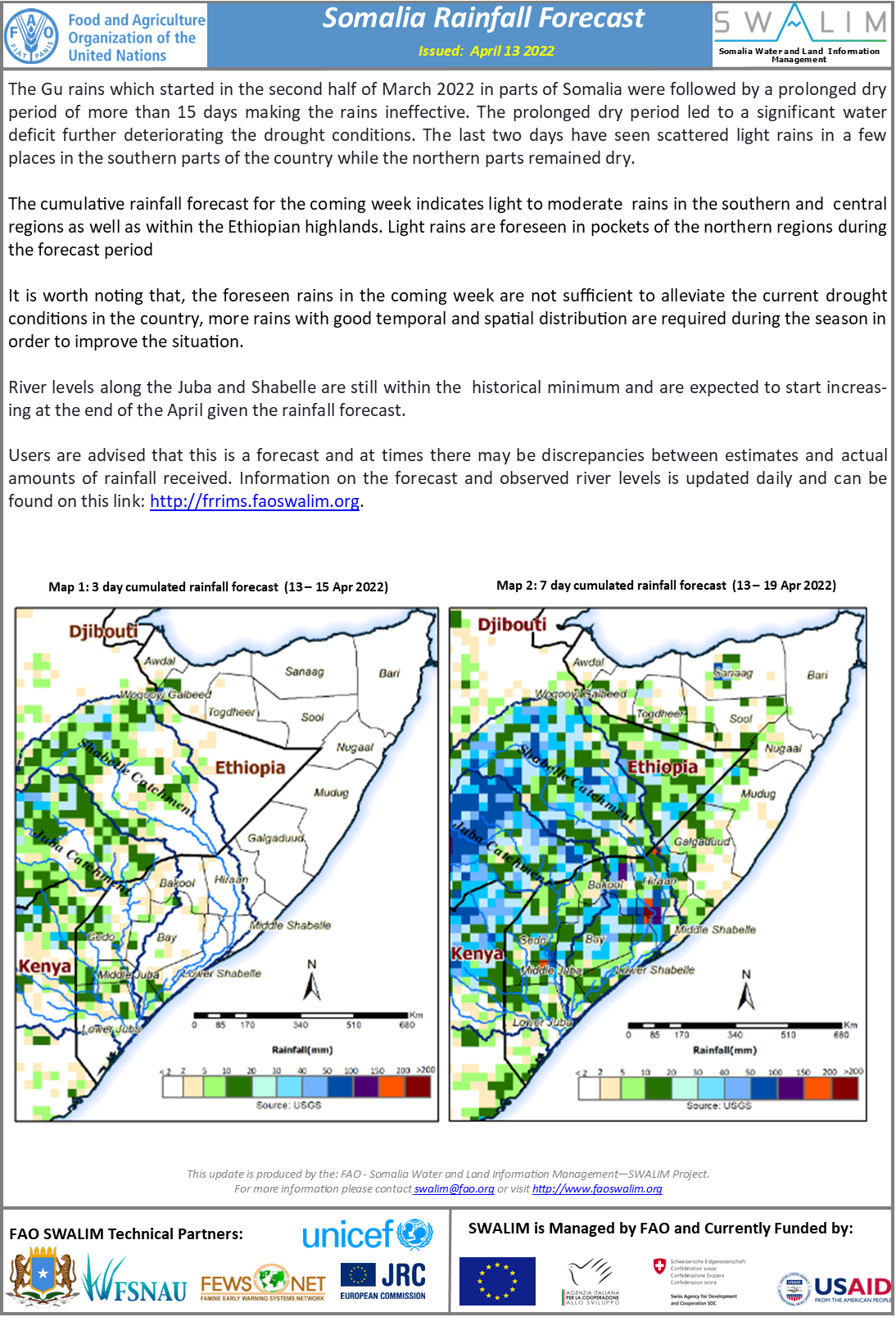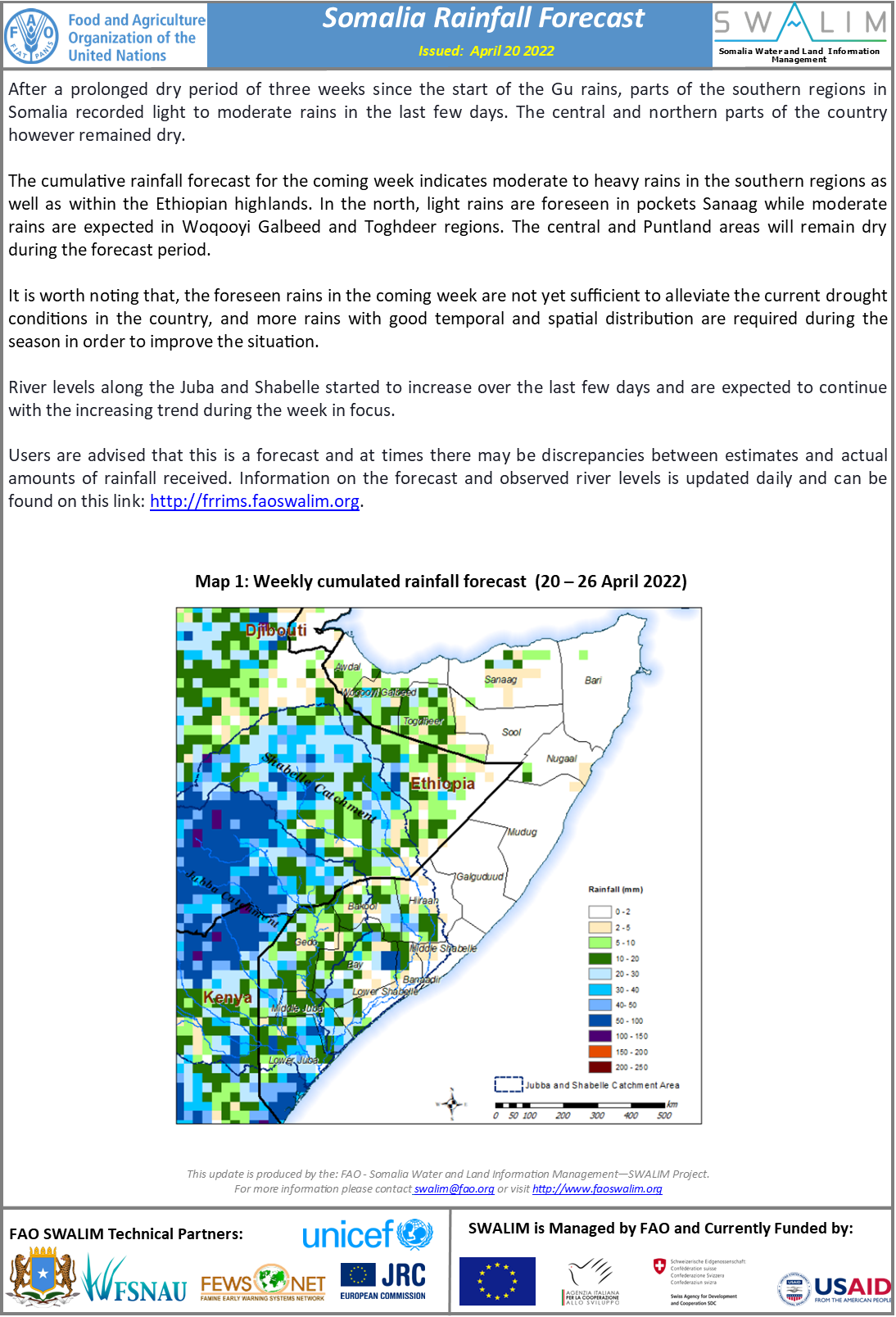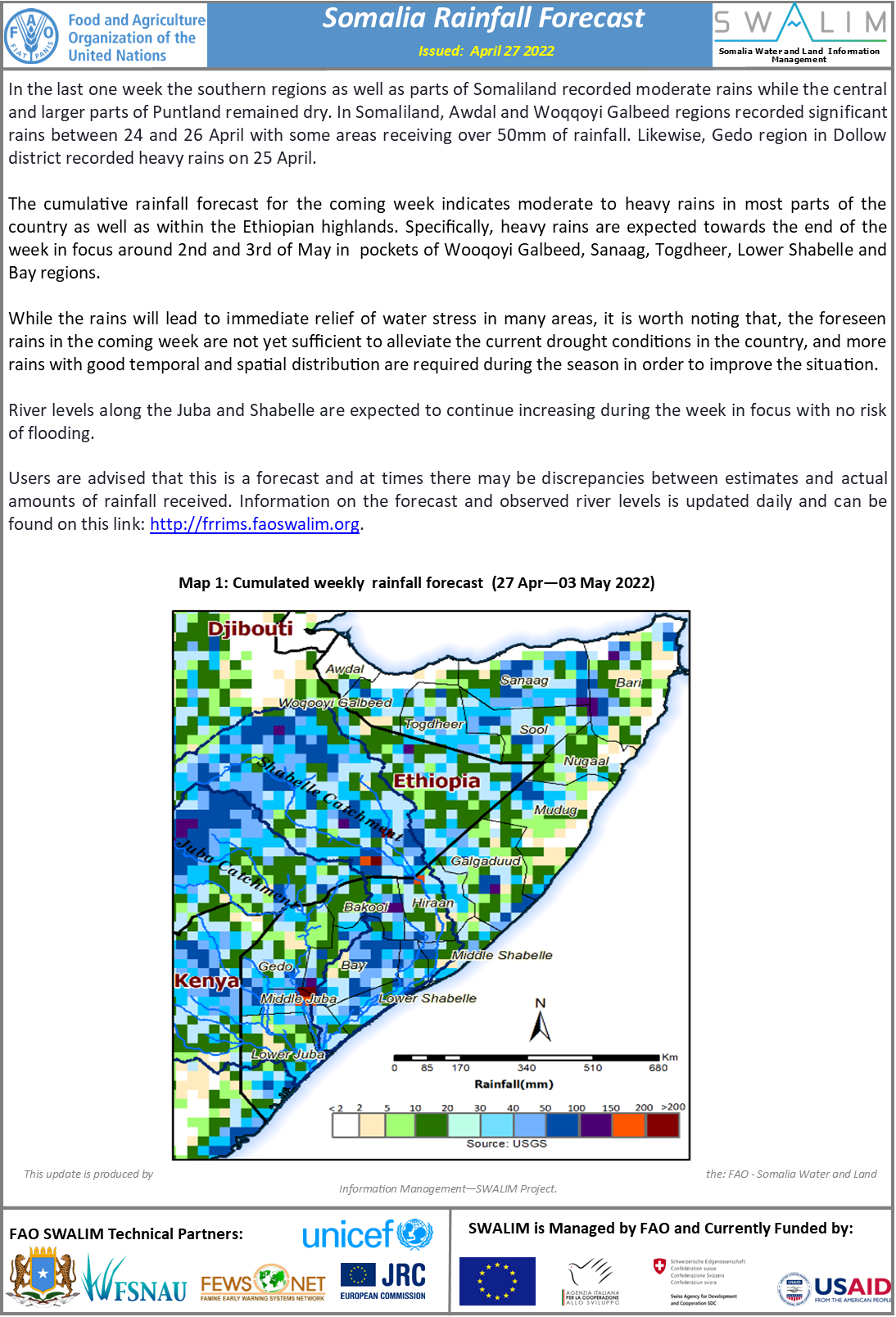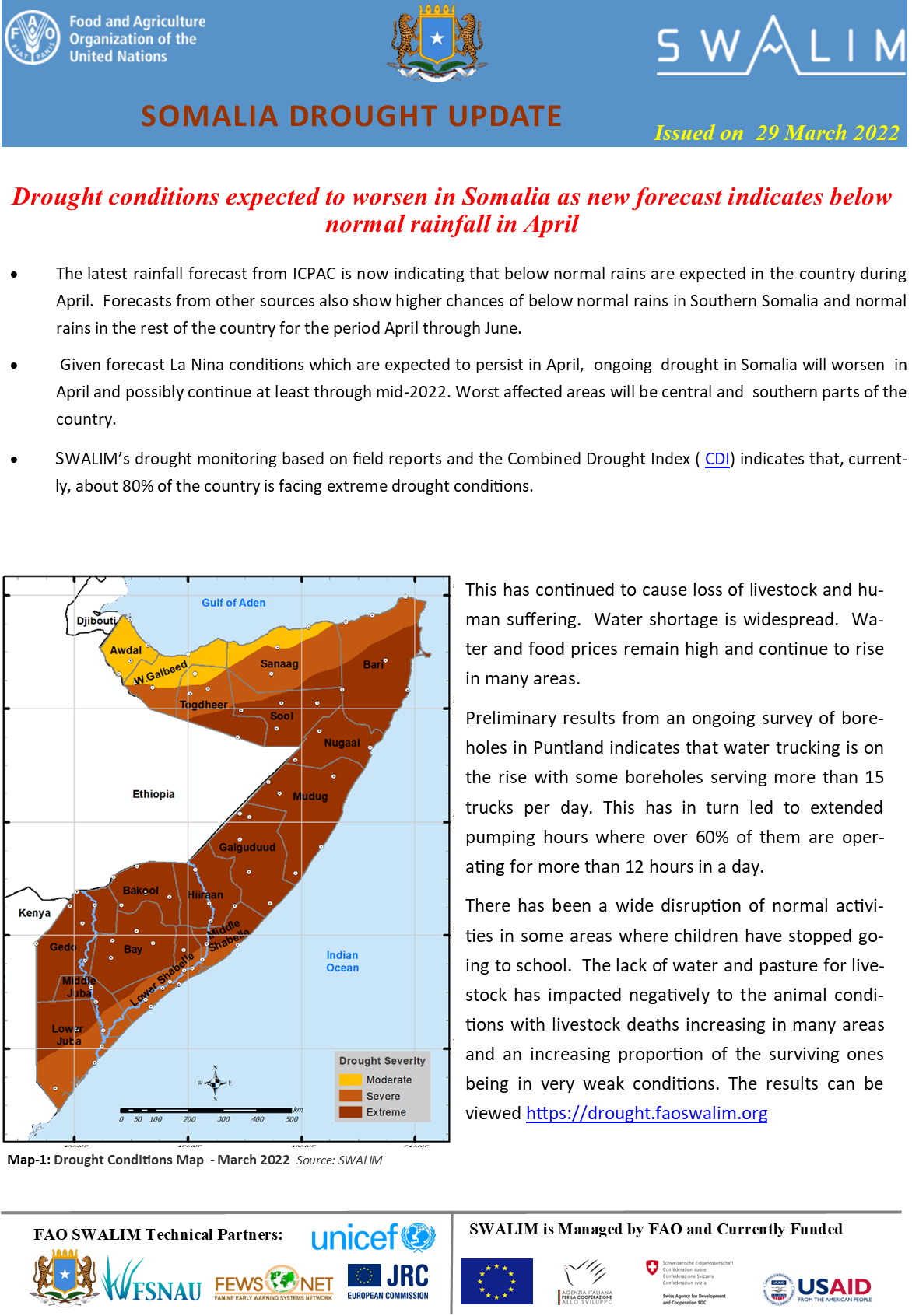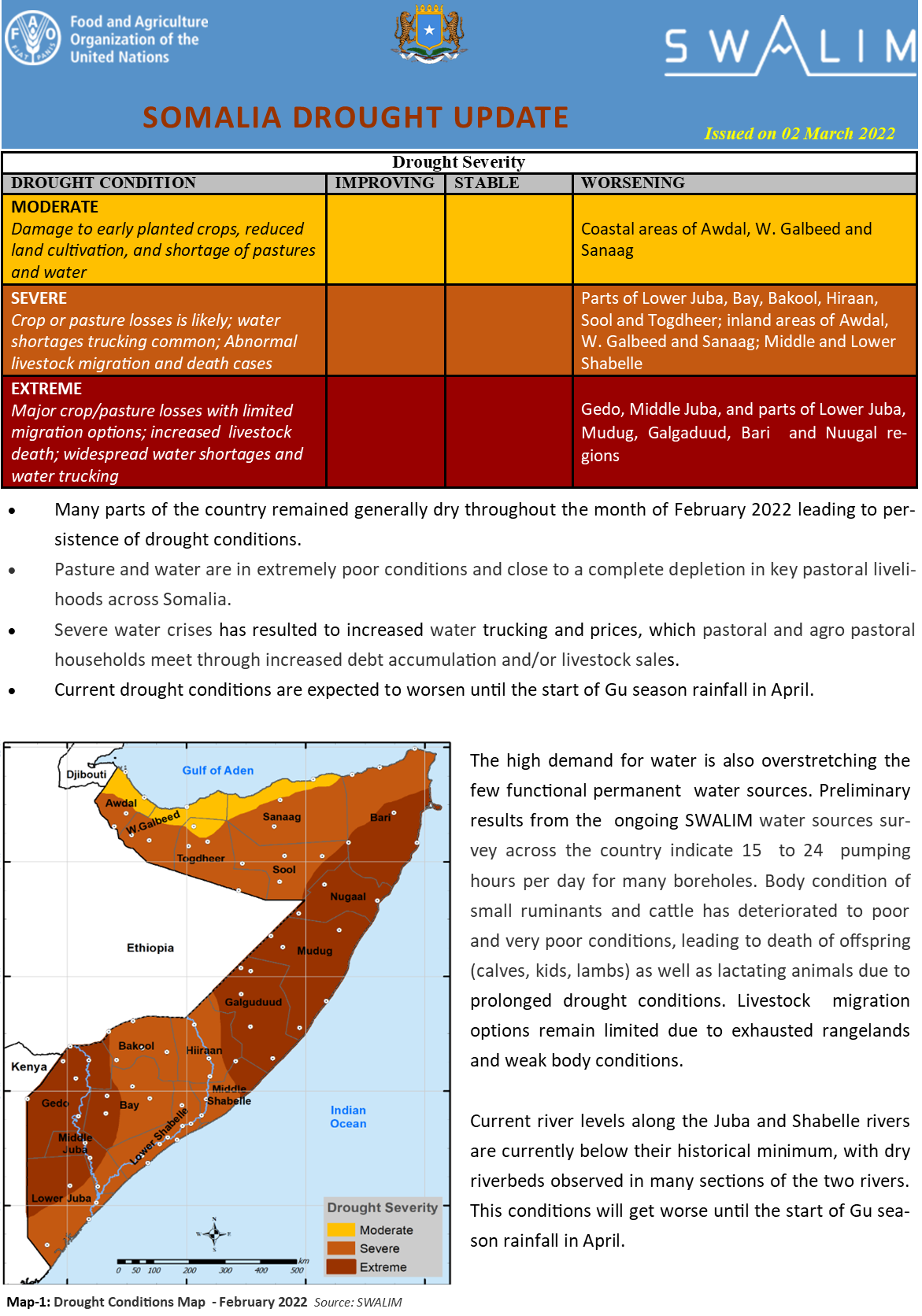Library Catalog
Latest Documents and Publications listed. Use search terms in the box below to find what you need
Somalia Rainfall Forecast – Issued 19 May 2022
In the last two weeks there has been a significant reduction of rainfall across Somalia except for a few places along the southern coast. Generally, the seasonal rains have been low in parts of the country, while in other parts localized heavy storms were experienced within a few days, resulting to flash floods such as Las Anod in Sool Region, Ceerigabo in Sanaag, and Jedaal/Ufeyn in Bari Region.
The cumulative rainfall forecast for the next seven days shows light rains along the coastal areas of Lower Juba. Scattered light rains are also expected in parts of the central and southern regions. Most parts of Somaliland and Puntland will remain dry within the coming week. In the Ethiopian highland where Juba and Shabelle Rivers originate light rains are expected within the same period.
It is worth noting that the Gu 2022 rainy season started late in Somalia, and the rainfall amounts recorded so far are below normal in many parts of the country, with poor temporal and spatial distribution. More rains are required to alleviate the current drought conditions. With no significant rains foreseen as the season comes to an end, the existing drought situation may deteriorate further in all the water dependent sectors.
River levels along the Juba and Shabelle reduced over the last one week, and the trend is expected to continue in the coming week, given the rainfall forecast.
Publication Type:
Rainfall Forecast
Publication Date:
Author:
Corporate Author:
Somalia Rainfall Forecast – Issued 25 May 2022
The last two weeks have seen a significant reduction of rainfall across Somalia marking a possible early end of the Gu 2022 rainfall season. There is cause for concern as observed rainfall records indicate that some parts in the central regions of Galmudug as well as Bari and Nugaal regions in Puntland received minimal rains since the start of the season. Cumulatively, the rainfall amounts recorded so far are below average with a typical poor distribution in space and time. This marks the fourth consecutive failed rainy season in Somalia, a situation that has not been witnessed in the recent history.
According to current climate model (https://iri.columbia.edu/our-expertise/climate/forecasts/enso/current/), indicate there is 62 per cent (62%) chance of the La Nina phenomena during the June to August 2022 period. The phenomena is largely associated with drier than normal periods in the country. With no significant rains foreseen as the season comes to an end and the La Nina predictions, the existing drought situation will deteriorate further in Somalia.
The cumulative rainfall forecast for the next seven days is calling for a further reduction of the seasonal rains with light rains expected in pockets of a few regions. In the same period moderate to low rains are expected in the upper parts of the Ethiopian highlands.
River levels along the Juba and Shabelle reduced over the last one week, and the trend is expected to continue in the coming week, given the rainfall forecast.
Publication Type:
Rainfall Forecast
Publication Date:
Author:
Corporate Author:
Somalia Rainfall Forecast – Issued 04 May 2022
In the last one week many parts of Somalia recorded moderate rains. In Somaliland, stations like Amoud, Borama, Yagori, Waridaad and Malawle recorded significant rains of above 70 mm. In the South, many stations including Bur Hakabar, Balcad, Bardheere and Buale recorded rainfall between 15mm to 25mm.
The last 24 hours saw heavy rains in parts of Puntland in Bari region and areas around Las Canood. This has led to flash floods subsequently causing damage in different sectors.
The cumulative rainfall forecast for the coming week indicates moderate to heavy rains in parts of the central and southern regions of the country especially in Galgaduud, Hiraan and Lower Juba, while light to moderate rainfall of below 30 mm is expected within the Ethiopian highlands. Most parts of Somaliland and Puntland are expected to receive little or no rains in the coming one week.
Given the rainfall forecast, flash flooding may occur in the southern areas of Galgaduud region and along the coastal areas of Lower Juba between 04 and 05 May 2022, .
While the rains experienced since the start of the Gu season have reduced water stress in many areas, it is worth noting that, the foreseen rains in the coming week are not yet sufficient to alleviate the current drought conditions in the country, and more rains with good temporal and spatial distribution are required during the season in order to improve the situation. Besides, the cumulative rainfall forecast for the month of May 2022 is expected to be below normal in most parts of the country according to ICPAC.
With the rains experienced during the last week in the country and the Ethiopian highlands, river levels along the Juba and Shabelle increased sharply over the last few days and will continue increasing during the week in focus with no risk of flooding.
Publication Type:
Rainfall Forecast
Publication Date:
Author:
Corporate Author:
Somalia Rainfall Forecast – Issued 13 April 2022
The Gu rains which started in the second half of March 2022 in parts of Somalia were followed by a prolonged dry period of more than 15 days making the rains ineffective. The prolonged dry period led to a significant water deficit further deteriorating the drought conditions. The last two days have seen scattered light rains in a few places in the southern parts of the country while the northern parts remained dry.
The cumulative rainfall forecast for the coming week indicates light to moderate rains in the southern and central regions as well as within the Ethiopian highlands. Light rains are foreseen in pockets of the northern regions during the forecast period
It is worth noting that, the foreseen rains in the coming week are not sufficient to alleviate the current drought conditions in the country, more rains with good temporal and spatial distribution are required during the season in order to improve the situation.
River levels along the Juba and Shabelle are still within the historical minimum and are expected to start increasing at the end of the April given the rainfall forecast.
Publication Type:
Rainfall Forecast
Publication Date:
Author:
Corporate Author:
Somalia Rainfall Forecast – Issued 20 April 2022
After a prolonged dry period of three weeks since the start of the Gu rains, parts of the southern regions in Somalia recorded light to moderate rains in the last few days. The central and northern parts of the country however remained dry.
The cumulative rainfall forecast for the coming week indicates moderate to heavy rains in the southern regions as well as within the Ethiopian highlands. In the north, light rains are foreseen in pockets Sanaag while moderate rains are expected in Woqooyi Galbeed and Toghdeer regions. The central and Puntland areas will remain dry during the forecast period.
It is worth noting that, the foreseen rains in the coming week are not yet sufficient to alleviate the current drought conditions in the country, and more rains with good temporal and spatial distribution are required during the season in order to improve the situation.
River levels along the Juba and Shabelle started to increase over the last few days and are expected to continue with the increasing trend during the week in focus.
Publication Type:
Publication Date:
Author:
Corporate Author:
Somalia Rainfall Forecast – Issued 27 April 2022
In the last one week the southern regions as well as parts of Somaliland recorded moderate rains while the central and larger parts of Puntland remained dry. In Somaliland, Awdal and Wooqoyi Galbeed regions recorded significant rains between 24 and 26 April with some areas receiving over 50mm of rainfall. Likewise, Gedo region in Dollow district recorded heavy rains on 25 April.
The cumulative rainfall forecast for the coming week indicates moderate to heavy rains in most parts of the country as well as within the Ethiopian highlands. Specifically, heavy rains are expected towards the end of the week in focus around 2nd and 3rd of May in pockets of Wooqoyi Galbeed, Sanaag, Togdheer, Lower Shabelle and Bay regions.
While the rains will lead to immediate relief of water stress in many areas, it is worth noting that, the foreseen rains in the coming week are not yet sufficient to alleviate the current drought conditions in the country, and more rains with good temporal and spatial distribution are required during the season in order to improve the situation.
River levels along the Juba and Shabelle are expected to continue increasing during the week in focus with no risk of flooding.
Publication Type:
Rainfall Forecast
Publication Date:
Author:
Corporate Author:
Somalia Drought Update & April 2022 Rainfal Outlook
The latest rainfall forecast from ICPAC is now indicating that below normal rains are expected in the country during April. Forecasts from other sources also show higher chances of below normal rains in Southern Somalia and normal rains in the rest of the country for the period April through June. Given forecast La Nina conditions which are expected to persist in April, ongoing drought in Somalia will worsen in April and possibly continue at least through mid-2022. Worst affected areas will be central and southern parts of the country. SWALIM’s drought monitoring based on field reports and the Combined Drought Index indicates that, currently, about 80% of the country is facing extreme drought conditions.
This has continued to cause loss of livestock and human suffering. Water shortage is widespread. Water and food prices remain high and continue to rise in many areas. Preliminary results from an ongoing survey of boreholes in Puntland indicates that water trucking is on the rise with some boreholes serving more than 15 trucks per day. This has in turn led to extended pumping hours where over 60% of them are operating for more than 12 hours in a day.
There has been a wide disruption of normal activities in some areas where children have stopped going to school. The lack of water and pasture for livestock has impacted negatively to the animal conditions with livestock deaths increasing in many areas and an increasing proportion of the surviving ones being in very weak conditions.
Juba and Shabelle river levels continued to decrease during the month of March. The graphs in Figure 2 & 3 show comparison of 2021/22 and the short term mean (2002 to 2022) for Shabelle and Juba river levels at Belet Weyne and Luuq stations, respectively. Current river levels are lower than the short term mean for both stations. Irrigated agriculture in the lower reaches of the two rivers have been seriously hampered by the low river levels . At Luuq along the Juba river in Gedo region, the unprecedented low river levels has exposed the dry river bed.
According to the revised March to May 2022 seasonal forecast issued by IGAD Climate Prediction and Application Center (ICPAC) on 28 March 2022, there is a greater likelihood of below average rainfall in April 2022 in the southern pars of Somalia as well as the adjacent Ethiopian highlands as shown on Map 2.
High temperatures are expected during the same month of April. High temperatures will lead to increased evaporation and increased demand for water among livestock, leading to worsening drought conditions. Following the failure of three consecutive rainy seasons since October 2020, and forecast below average 2022 Gu season rainfall, the cumulative effect will likely lead to extended and worsening drought conditions in Somalia.
The seasonal rains started in the last week of March in some southern and a few places in the north, briefing a temporary relief to these areas. Drought condition will likely persist and could even worsen unless the rains continue in the coming weeks and months. While current forecasts indicate a likely below average March to May 2022 Gu season rainfall, flash floods or extended dry periods may occur in some areas. SWALIM will keep updating this forecast for shorter lead time and will share with you through regular bulletins throughout the rainfall season.
Publication Type:
Rainfall Forecast
Publication Date:
Author:
Corporate Author:
Somalia Drought Update & GU 2022 Rainfall Outlook–Issued March 2022
Many parts of the country remained generally dry throughout the month of February 2022 leading to persistence of drought conditions. Pasture and water are in extremely poor conditions and close to a complete depletion in key pastoral livelihoods across Somalia. Severe water crises has resulted to increased water trucking and prices, which pastoral and agro pastoral households meet through increased debt accumulation and/or livestock sales. Current drought conditions are expected to worsen until the start of Gu season rainfall in April.
The high demand for water is overstretching the few functional permanent water sources in the country. Preliminary results from the ongoing SWALIM water sources survey across the country indicate 15 to 24 pumping hours per day for many boreholes. Body condition of small ruminants and cattle has deteriorated to poor and very poor conditions, leading to death of offspring (calves, kids, lambs) as well as lactating animals due to prolonged drought conditions. Livestock migration options remain limited due to exhausted rangelands and weak body conditions. Current river levels along the Juba and Shabelle rivers are currently below their historical minimum, with dry riverbeds observed in many sections of the two rivers. This conditions will get worse until the start of Gu season rainfall in April.
Publication Type:
Rainfall Outlook
Publication Date:
Author:
Corporate Author:
Somalia Rainfall Forecast – Issued 25 March 2022
In the last 24 hours, a few places in Somalia received light to moderate rains marking a possible start of the Gu rain season. Galdogob and Galckaayo in the central areas recorded 37 mm and 14 mm respectively. Field reports also indicate that there was moderate rains in parts of Bay and Bakool regions during the same period.
It is worth noting that, the foreseen rains in the coming week are not sufficient to alleviate the current drought conditions in the country, more rains with good temporal and spatial distribution are required during the season in order to improve the situation.
The cumulative rainfall forecast for the coming week indicates a continuous spread of rains in the southern and central regions. No rains are foreseen in the northern regions during the forecast period. In the Ethiopian highland, whose rainfall is largely responsible for increase in river flow along the Juba and Shabelle Rivers inside Somalia, light to moderate rainfall is foreseen in the coming week.
River levels along the Juba and Shabelle are still within the historical minimum and are expected to start increasing in April given the rainfall forecast.
Publication Type:
Rainfall Forecast
Publication Date:
Author:
Corporate Author:
Status of river breakages along the Juba and Shabelle Rivers in Somalia – February 2022
Three consecutive poor rainy seasons within the Juba and Shabelle River basins inside Somalia and the Ethiopian highlands have led to the current serious hydrological drought along the two rivers. The river levels in the upper sections are currently at their historical minimum, while the mid and lower sections of the Shabelle River having run dry. With no rains expected in February and most of March, the river flow will continue to decline.
The reduced river flow along the two rivers has negatively impacted agriculture production, domestic and livestock water use. This has also led to an increase of new river breakages as the riverine communities attempt to extract the limited resource to support livelihood activities.
SWALIM has completed analysis and mapping of the river breakages along the two rivers using very high resolution satellite images acquired thanks to the kind contribution of the Embassy of France. The study has identified 101 open points along the Shabelle, out of which 24 points are new and the rest have remained open since the last survey in August 2021. Along the Juba River, 35 open points were identified out of which 5 are new points. During this drought period, it is expected that the riverine communities will continue to extract water from the rivers by breaching the banks and this will only see an increase of the open river bank points.
Several other weak points which are not necessarily open but have the potential to overflow or break were identified during the analysis. This information is available in the SWALIM Flood Risk and Response Information Management System (http://frrims.faoswalim.org/rivers/breakages).
It is worth noting that since the last survey in August 2021, several agencies including FAO have made efforts to close about 23 of the open river banks and reinforced about 37 of weak river embankments that could otherwise flood when river levels rise.
With the Gu rains expected in April 2022, the rise in river levels will consequently lead to floods resulting from the existing open river bank points and weak river embankments. It is therefore advisable to close the open points and reinforce the weak points before the start of the Gu season to avoid the negative impacts of riverine flooding.
The methodology heavily relied on satellite imageries with limited field verification. Open breakages might have been omitted in some cases due to cloud cover or vegetation cover along the embankments
Publication Type:
Map
Publication Date:
Author:
Corporate Author:
Pages
 RSS feed [compliant with the Agris AP] |
RSS feed [compliant with the Agris AP] |  Agris AP XML
Agris AP XML


